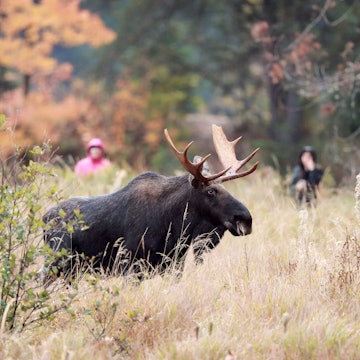

Remote Churchill is a magnet for those seeking wildlife and nature experiences – especially polar bears. Thorsten Milse/robertharding/Getty Images
Located on Manitoba’s Hudson Bay, and known as the ‘Polar Bear Capital of the World’, the remote, 900-person town of Churchill is a magnet for those seeking wildlife and nature experiences. But furry predators, beluga whales and awe-inspiring nature are not the only thing on a traveler’s menu here.
A 250-year old fort and fascinating local museums lure you into a rich past of the region’s fur trading adventures. And the town boasts some of the world’s quirkiest and friendliest characters; finding out what makes them tick is a huge aspect of a visit here.
Wildlife and nature
Starting with the obvious draw: Churchill’s surrounds are a treasure of unforgettable land and sea wildlife experiences. May to June sees wonderful birdlife such as Arctic terns, snowy owls, loons and cranes; while July to November brings polar bear sightings. From July to August you may be able to glide alongside beluga whales in the Churchill River, when as many as 57,000 of these beautiful creatures migrate to Hudson Bay. And, while the aurora is said to appear for 300 days, the winter months of February and March are when the northern lights put on their best celestial performance – if conditions are conducive, greens and violets dance and sway across the sky. Several local companies offer day trips (or longer) across all budget ranges.

Seductive desolation
As amazing as these experiences are, at some stage you’ll find yourself in the main hub, Churchill, a frontier town on the edge of the Subarctic. Don’t ignore the approach to town, along the flat expanse from the airport (Visitors can arrive via a direct flight from Winnipeg or a twice-weekly VIA Rail train line). Here, the polar bear warning signs are travelers’ favorite insta-snaps, but don’t be fooled: locals impress the dangers of bears coming near, or into, town (more on this later).
No matter the weather in this remote location, its starkness is surprisingly beautiful. In winter, when temperatures can drop to -50°C with wind chill, ice stretches as far as the horizon, even freezing Hudson Bay. In summer, when the thermometer can rise to 21°C, the tundra is covered in wildflowers: purple fireweed, orange Iceland poppy, and dainty white primula. Here and there, small spruce trees and their one-sided branches attest to the prevailing winds (a useful navigation tool, and likely to have been used by the town’s ancient peoples: the pre-Dorset, Dorset and ancestors of the region’s Inuit).
The streets of Churchill
Named after John Churchill, the third Governor of the famous British fur trading company, Hudson’s Bay Co, Churchill is a compact grid with clapboard buildings, three churches, and peaked-roofed houses. A number of buildings in the twelve or so streets are covered with massive, vivid murals, part of the artistic Sea Walls project.
Most of the rustic eateries and tourist services line the main thoroughfare Kelsey Blvd. From here, it’s easy to hit the sights on foot (again, depending on bear season; ask the locals): Boulder Beach, the town’s beach, and an Inukshuk, a structure of stones stacked vertically and traditionally used by the Inuit as a landmark.

Do not miss the extraordinary Itsanitaq Museum, a not-for-profit organization that displays stunning pieces of Inuit carvings made of ivory from walrus tusks, whalebone and soapstone from the Central and East Arctic. Missionaries started the collection in the 1930s and 1940s to understand local communities through their art. These beautiful, evocative pieces depict scenes such as fishing, man hunting walrus with a harpoon, and a polar bear hunt from a whaleboat.
Built in 1930, the Canadian National Railway Station of Churchill houses the Parks Canada Visitor Centre with some excellent exhibits on the history of the area and local cultures.
Polar bears
Some of the street signs in Churchill feature a picture or image of a polar bear. While this might seem cute, locals will leave you in no doubt about the dangers of coming across a bear in town; they often leave their vehicles and homes unlocked as a safety precaution in case people need to access them in a hurry.
Churchill even has a polar bear holding facility, a ‘jail’ for recalcitrant bears that wander into town and are repeat offenders. The bears are tranquilized, airlifted by helicopter and then released. Visitors can inquire if and when this will take place and can view the proceedings from a safe distance.
The Churchillians
Churchill is the type of place where you pop your head around a store door and say hello, and sit and chat to those inside. The delightfully eccentric locals – some of who are as comfortable gutting a fish as hunting a moose, caribou, and wolves – are some of the most hospitable people around.
For some local takes, visit Dale and Rhoda de Meulles who run the hardware store, or Mark Reynolds, artist and jeweler, whose polar bear renditions are lovely souvenirs (he often sets up a stand at the airport for arrivals and departures). At the post office, Postmistress Shavon is more than happy to put the polar bear rubber stamp on documents and letters for kids, young and old.

Around Churchill
Reflecting Churchill’s incredible history as a fur trading post is the 250-year-old Prince of Wales Fort, located on the isolated Eskimo Point where the Churchill River flows into Hudson Bay. The current fort (it had various revivals) was completed in 1771, and it’s so evocative it could be from the pages of a children’s picture book.
Often included in cultural tours, Cape Merry is the relic of a battery, 2km northwest of town; if you’re lucky you might spot belugas from the shore. Adventurous types can organize a tour with a licensed operator to the remarkable Wapusk National Park located between boreal forest and arctic tundra. It was established to protect bear denning sites and is home to over 200 bird species.
Lonely Planet produced this content for Travel Manitoba. All editorial views are those of Lonely Planet alone and reflect our policy of editorial independence and impartiality.
















